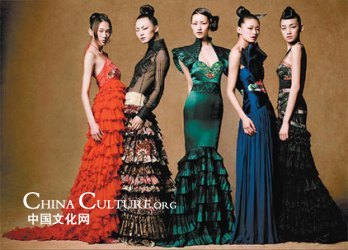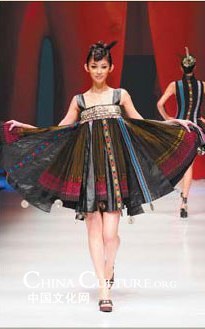more>>More News
- National Day
- ways to integrate into Chinese style life
- Should they be in the same university with me?!!
- Chinese Ping Pang Legend: the Sun Will Never Set
- A Glance of those Funny University Associations
- mahjong----The game of a brand new sexy
- Magpie Festival
- Park Shares Zongzi for Dragon Boat Festival
- Yue Fei —— Great Hero
- Mei Lanfang——Master of Peking Opera
From minority culture to global fashion: Chinese cuties embrace world stage
By admin on 2014-12-15
When foreigners are amazed and enchanted in the mysterious culture and arts of China, Chinese element has already join the rhythm of global fashion. Cuties bring forth the vogue of minority style on world stage. You may pick them up in most fashionable cities like Paris or Milan.
Embroidered shoes, pleated batik skirts, shining silver accessories of the Miao minority - these are the exotic Chinese flavors that will pervade the Paris fashion trade fair, which begins in the world's fashion capital today.

China's promising young designers, He Jian, Zhu Xiaoyu and Yang Jie - all of whom are winners of the latest Seven Brand Cup China Style Costume Creation Contest - will debut at this premier fashion event that brings together the most cutting-edge designs and collections in Europe.
"We think Chinese designers can win international recognition by incorporating unique Chinese elements into world fashion trends," says He Jian. His collection features innovative combinations of ethnic costumes and modern men's casuals, while Zhu Xiaoyu and Yang Jie both derive inspiration from the costumes of the Miao and Zhuang minorities. Today's youngsters have been inspired by the success of other Chinese designers who have starred previously in such fashion capitals as Milan, New York and London.
Zhang Zhifeng, art director of NE Tiger Clothing Company, is one such example. The veteran designer wants to build NE Tiger as an international luxury brand in China - in the same league as Louis Vitton and Armani.
Zhang has explored the use of Chinese Yunjin, the special brocade once reserved for royalty, in his collections. He adopts the traditional "seamless" weaving method in his haute couture fabrics, once used exclusively for the brocade dragon robe of the emperors. Exquisite handmade Chinese embroideries of the phoenix and peony are also widely used. As the making of the brocade and the embroideries are extremely time-consuming and complicated, it usually takes Zhang and his skilled craftsmen months to make one suit, with the price hovering in the region of 50,000 yuan ($6,756).
"Yunjin and embroidery mark the high points of Chinese clothing culture. I hope to arouse an awareness and appreciation of these rare gems through my designs," says Zhang.

His collections feature a harmonious combination of traditional culture and modern fashion elements. He includes Western fashion inspirations and solid cutting techniques into his designs and applies georgette, damask, Italian baldachin, lace and Swarovski crystals to Chinese silk and brocade to redefine the Western gown, corsage, pleat skirt and fish skirt.
Zhang's persistence has helped NE Tiger, the once barely known local brand, to become the leading Chinese haute couture brand for furs, evening gowns and wedding clothes, in just 10 years. His studios are scattered across the United States, France, Italy and Russia, and his designs have even won over royalty in Europe. For instance, Joachim Holger Waldemar Christian, the prince of Denmark, chose NE Tiger, to make the evening gown for his fiance.
For Chinese fashion icon Mark Cheung, an outstanding Chinese designer must have a deep understanding of his own culture and land to be able to make beautiful designs.
Cheung is regarded as representing of the first generation of Chinese designers and his annual fashion show is seen as the most important event in Chinese fashion circles. The 45-year-old wears many hats, including vice-chairman of the China Association of Fashion Design and chairman of the China Fashion Committee of Asia Fashion Union.
Whereas Zhang's collections incorporate underlying ethnic tones, Cheung's work has widely recognized landscapes and patterns of China as its crucial motifs.
Since 2000, the veteran designer has held fashion shows every year featuring Chinese landscapes and ethnic culture. For instance, The Soul of the Nations collection expresses the splendid and varied styles of 56 minorities; Royal Flavor radiates the glory and luxury of royal courts of the different dynasties of the past; Forbidden City reproduces the beauty and grandeur of the old buildings, and South China captures the striking scenery of ancient water towns and gardens.
All of Cheung's collections are known for their rich palette, which includes pure whites, darker tones of brown and jade, bright red and the shining yellow of the imperial Forbidden City. Cheung's fascination with ancient building styles can be seen in the lavish use of symmetry, bias cutting, pleating, carving lace-trimming, fagoting, sequining and beading. These techniques, combined with pure innovation, have enabled Zheung to fuse traditional culture with cutting-edge fashion.
Unlike Mark Cheung and Zhang Zhifeng, young designer Ma Ke has taken a different route.
Ma caused a sensation in February last year with her debut during the Paris ready-to-wear season. More performance art than fashion show, her models appeared on the catwalk with their clothes and skin caked in mud, like warriors from the terracotta army of Emperor Qinshihuang.
Buoyed by the success of her Exception label, which is sold in around 50 boutiques across China, she has recently launched her couture line Wuyong (which means "useless" in Chinese.)
And at the recent Paris Fashion Week, her invitation to show on the sidelines of the collections presented by the grand couture houses is a first for China, which has already marked a presence in the ready-to-wear segment in Paris since 2006.
The Chinese designer is also the only newcomer this season among the 20 or so would-be couturiers invited to show their collections alongside the houses officially deemed worthy of the "haute couture" designation.
Ma has given up the stereotyped Chinese elements such as stand collars and embroideries in her designs. A naturalist, she uses cotton and flax in all her collections and focuses on simple and natural styles in white, brown, grey and blue.
"Promoting Chinese fashion doesn't mean you have to stick
to Chinese icons. Heavily Chinese designs are not trendy and can hardly be
accepted by international fashion circles," says Ma.A believer in the philosophy
of Lao Zi that sees clothes as the servant of the wearer's soul, Ma Ke is
recognized for her silent, organic and reflexive clothing that is creative and
experimental. She has been praised by Le Monde and Vogue as a genius and her
collection lauded as everlasting artwork.
- Contact Us
-
Tel:
0086-571-88165708
0086-571-88165512E-mail:
admission@cuecc.com
- About Us
- Who We Are What we do Why CUECC How to Apply
- Address
- Study in China TESOL in China
Hangzhou Jiaoyu Science and Technology Co.LTD.
Copyright 2003-2024, All rights reserved




 Chinese
Chinese
 English
English
 Korean
Korean
 Japanese
Japanese
 French
French
 Russian
Russian
 Vietnamese
Vietnamese
